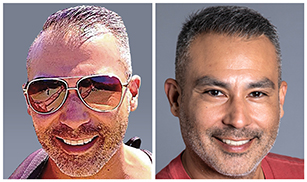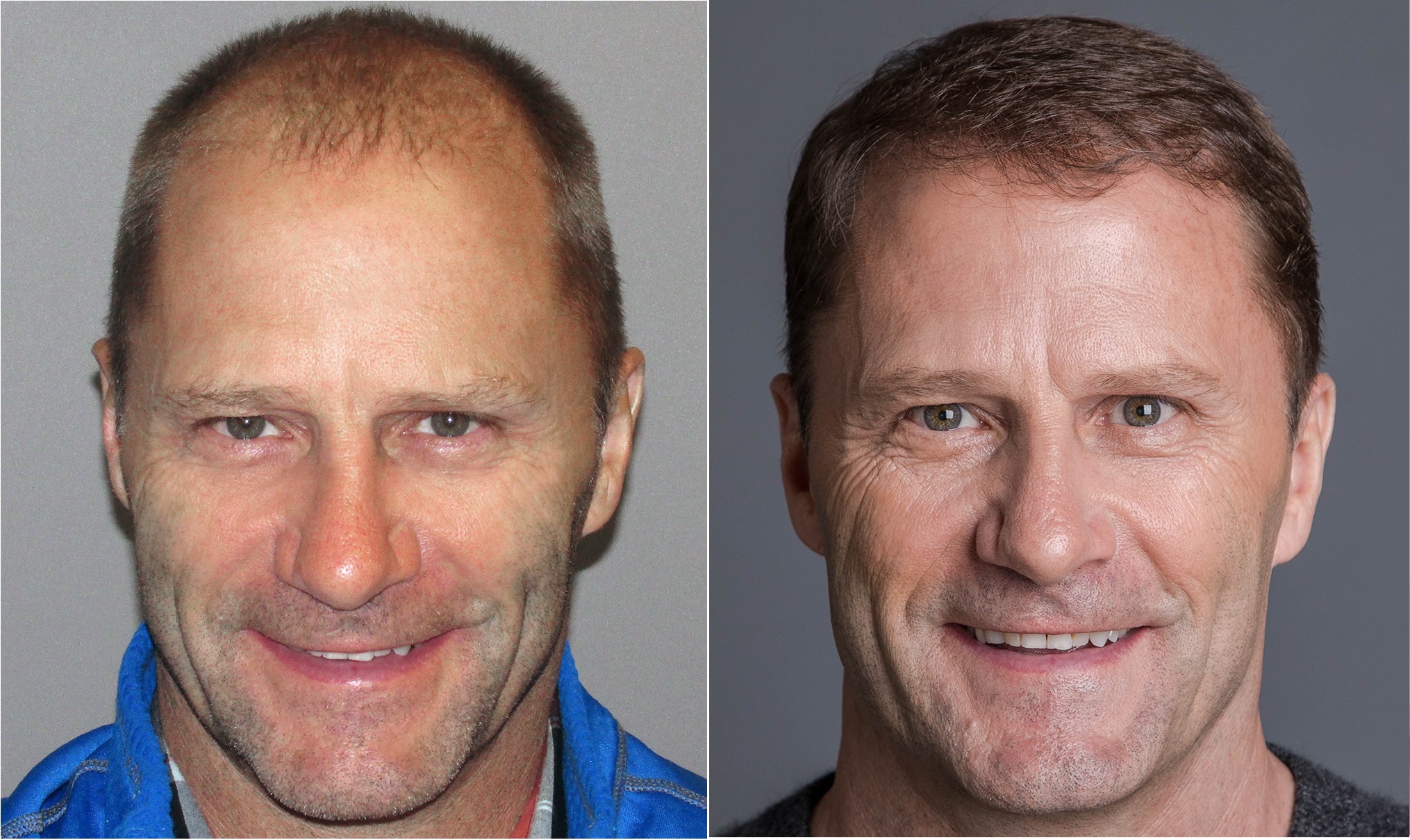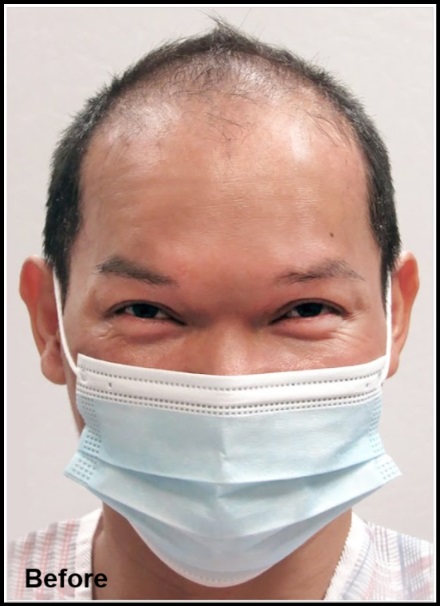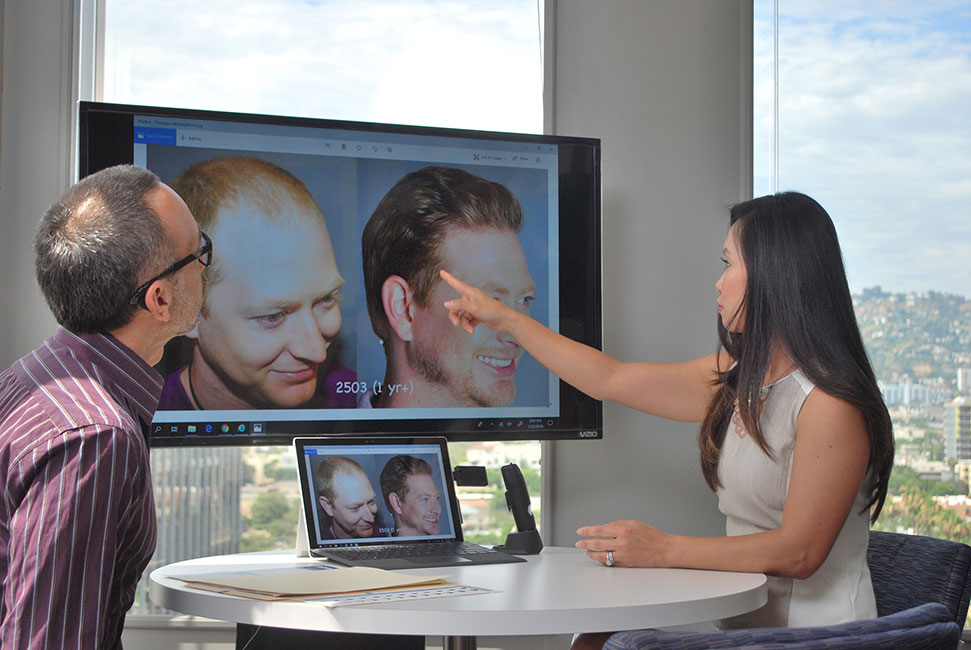Why Bosley FUE
Like all of our hair restoration procedures, a Bosley FUE hair transplant is performed under the supervision of a trained Bosley-affiliated physician. Our physicians have extensive experience with our proven hair restoration procedures. In fact, all of them have dedicated their practice to hair restoration. Re-creating the natural look of your hairline is their primary concern.
And, of course, you have The Bosley Guarantee. For all hair transplantation procedures performed by Bosley physicians, we will replace any non-growing hair transplant graft free of charge, provided the patient has adequate donor hair and meets the terms and conditions.
Benefits of an FUE Hair Transplant Procedure
The results are natural-looking and permanent
Patients can wear their hair at any length desired (No need to conceal donor area with longer hair)
It’s a state-of-the-art, minimally invasive technique
Utilizes advanced technology
There are no stitches, so the donor area heals within days
Less discomfort during the procedure
Scarring in the donor area is virtually undetectable, as there’s no linear scar
Who Is a Good Candidate for Follicular Unit Extraction?
The FUE hair transplant procedure is a great hair restoration option for a wide variety of people suffering from hair loss. The best candidates are those who have hair loss near the top of the head, along the hairline, or around the crown.
The cause of baldness can also impact whether you are a good candidate for this procedure. FUE hair transplants work best for those who have a natural condition that does not allow hair to grow or for those who have gone through some form of trauma to the area that prevents hair from growing.
Hair density is another factor that can affect whether you’re a good candidate for a hair transplant (including the FUE). The higher hair density you have in the donor area, the more grafts available for transplantation.
Hair texture can also have an impact. Those who naturally have wavy or curly hair will usually require fewer grafts to achieve their goals.
The flexibility of the scalp is another factor your hair follicle physician will look at when deciding if an FUE procedure is right for you. If you have a tighter scalp, FUE would be the procedure of choice as each hair is individually removed.
Each person’s hair loss is unique, and so is their journey to hair restoration. There are many factors that can influence whether you’re a good candidate for FUE. Schedule a consultation to speak with an expert about your hair transplant options.
What Does the Procedure Cost?
At Bosley, we determine the cost of FUE hair transplants per graft, which can vary depending on the size of the treatment area, the degree of hair loss, and what your goals are. The majority of our procedures cost between $6,000 and $12,000. Plus, we offer 3rd party financing and low monthly payments. The cost of your transplant will depend on your hair restoration goals and the number of grafts needed to achieve those goals.
We encourage anyone interested in a hair restoration transplant to schedule a no-obligation, in-person or video consultation with an experienced Bosley hair restoration expert. We gladly offer third-party financing options for follicular unit extraction to help you achieve a full, healthy head of hair.
Follicular Unit Extraction: An Affordable & Effective Solution
The Hair Society states that 35 million men and 21 million women in the US suffer from some form of hair loss. The International Society of Hair Restoration Surgery says that FUE hair transplantation procedures are currently the most popular hair transplant option.
So why is this method so popular? In addition to being effective and affordable, an FUE procedure is non-invasive and less likely to result in visible scarring. Because we extract one hair follicle at a time, there is a shorter recovery time and less discomfort during the procedure itself.
FAQs
How Should I Prepare for the FUE Procedure?
If you’re considering a hair follicle extraction procedure, the first thing to do is to schedule a consultation with us. During this consultation, we will discuss your full medical history as well as request a list of any medications you take. We will also examine the treatment area to ensure that an FUE transplant is the best option that will offer you the best results.
To prepare for your procedure, it’s recommended that you stop taking blood-thinning medications or supplements. However, it’s important that you consult with your primary care physician before stopping or changing any medication plan. We also recommend that you avoid vitamins or dietary supplements for at least two weeks before the procedure.
Leading up to the procedure date, it can help to perform scalp massages for 10 to 20 minutes a day. These massages can increase blood flow to your scalp for better results after your transplant. The Bosley Scalp Massager is a powerful red light device that can assist in this process. Additionally, it’s best to avoid cutting your hair for at least two weeks before your procedure.
What Can I Expect During Recovery?
While the average recovery time is short, you will need to take it easy for a few days after the procedure. In most cases, you will be able to return to work the next day, depending on what type of work you do. Your physician will provide specific guidelines about returning to work and provide a personalized recovery plan.
During the first two weeks, it’s important to be gentle with the donor and recipient areas. You should protect your scalp from the sun and any friction from external elements. Also, it’s best to sleep with your head elevated to reduce the swelling and to help avoid any swelling on your forehead. You can use over-the-counter painkillers to help with any discomfort.
During the first few days, avoid washing your hair. Within the first week, you can begin using special shampoo and other products to help remove any dry skin. Do not wear hats, beanies, or anything that compresses or creates friction on the donor area and newly transplanted grafts until instructed otherwise. After approximately two weeks, the transplanted hair will begin to shed and the new hair will begin to grow approximately three months after the procedure.
Are There Alternatives to FUE?
At Bosley, we offer one surgical alternative to FUE called follicular unit transplantation. This procedure involves removing the grafts as a group from the back of your head. During your consultation, your physician will discuss which surgery is right for your needs. We also offer Hybrid FUE & FUT procedures depending on a patient’s needs, as well as BioGraft, which combines an FUE with a non-surgical solution to help restore your hair.
While a hair transplant is the only way to fully restore your hairline, there are non-invasive options that can help reduce the rate of thinning and hair loss. If you’re looking for non-surgical alternatives, Bosley offers several non-invasive options:
- Scalp micropigmentation adds pigment to your scalp to give the appearance of a fuller head of hair.
- Low-level laser therapy is another non-surgical option that delivers specific wavelengths of energy to your scalp to stimulate hair growth.
- We also offer prescription topical products, including BosleyRX finasteride, which can help prevent further hair loss while also stimulating hair growth for a fuller, healthier head of hair.
Are There Any Risks or Side Effects Associated with Follicular Unit Extraction?
While side effects are rare, the most common side effects you may experience include minor bleeding, swelling, itching, or dry skin. Pain, swelling, and minor bleeding may happen right after the transplant, but it’s unlikely and will stop after a few days. Itching is a common reaction, and it occurs as your scalp begins to heal. Remember not to scratch your scalp to avoid disturbing the transplanted hair follicles. It’s rare to experience side effects like infection after a hair follicular unit extraction, but without proper aftercare, it is a possibility.











